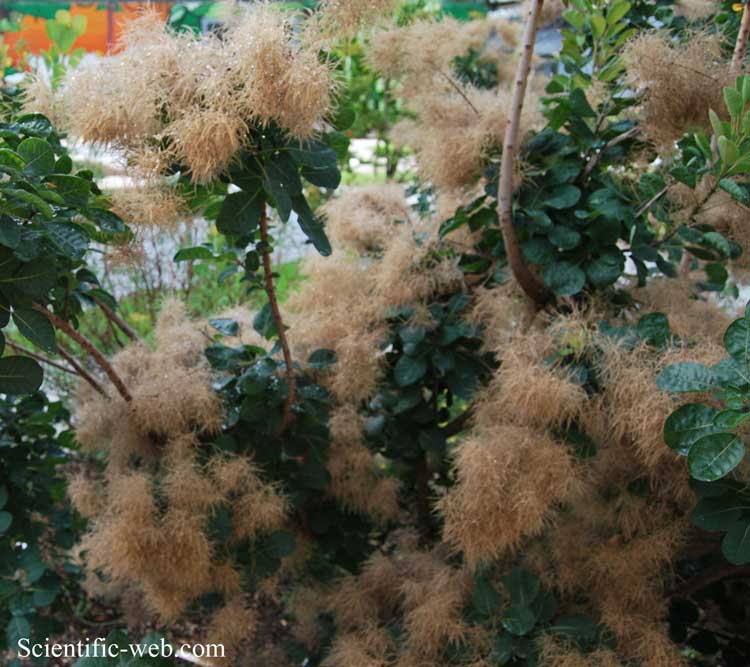
Cotinus coggygria , Photo: Michael Lahanas
Classification System: APG IV
Superregnum: Eukaryota
Regnum: Plantae
Cladus: Angiosperms
Cladus: Eudicots
Cladus: Core eudicots
Cladus: Rosids
Cladus: Eurosids II
Ordo: Sapindales
Familia: Anacardiaceae
Subfamilia: Anacardioideae
Genus: Cotinus
Species: Cotinus coggygria
Varietates: C. c. var. chengkouensis – C. c. var. cinerea – C. c. var. glaucophylla – C. c. var. pubescens
Name
Cotinus coggygria Scop., Fl. Carniol. ed. 2, 1: 220. 1771. nom. nov.
Synonyms
Cotinus arenaria (Wierzb. ex Engl.) F.A.Barkley
Cotinus cinerea (Engl.) F.A.Barkley
Cotinus coggygria subsp. glabra H.Kaur & M.Sharma
Cotinus coggygria var. velutina Engl.
Cotinus coriaria Duhamel
Cotinus cotinus (L.) Sarg.
Cotinus velutina (Engl.) F.A.Barkley
Rhus cotinus L.
Rhus laevis Wall. ex G.Don
Rhus obovatifolia Stokes
Rhus simplicifolia Salisb.
Rhus velutina Wall.
Distribution
Native distribution areas:
Continental: Europe
Austria, Bulgaria, Switzerland, Hungary, Slovakia, Romania, Germany (I), France, Italy, Slovenia, Croatia, Bosnia & Hercegovina, Montenegro, Serbia & Kosovo, Macedonia, Albania, Crimea, Greece, Kriti, Ukraine, E-European Russia, European Turkey
Continental: Asia-Temperate
Armenia, Georgia [Caucasus], Turkmenistan, Tajikistan, Turkey (E-Anatolia, N-Anatolia, NE-Anatolia, S-Anatolia, SE-Anatolia: Mesopotamian Anatolia, SSW-Anatolia, SW-Anatolia), Iran (Iranian Aserbaijan), Syria (coastal W-Syria, W-Syrian Mountains)
Continental: Asia-Tropical
Indian Subcontinent
India (Himachal Pradesh, Uttar Pradesh), Pakistan (Baluchistan, Kurram, Jhelum, Swat, Hazara, Murree), Jammu & Kashmir (Kashmir, Jammu), Nepal.
References: Brummitt, R.K. 2001. TDWG – World Geographical Scheme for Recording Plant Distributions, 2nd Edition
References
Hassler, M. 2018. Cotinus coggygria. World Plants: Synonymic Checklists of the Vascular Plants of the World In: Roskovh, Y., Abucay, L., Orrell, T., Nicolson, D., Bailly, N., Kirk, P., Bourgoin, T., DeWalt, R.E., Decock, W., De Wever, A., Nieukerken, E. van, Zarucchi, J. & Penev, L., eds. 2018. Species 2000 & ITIS Catalogue of Life. Published on the internet. Accessed: 2018 Aug. 07. Reference page.
International Plant Names Index. 2018. Cotinus coggygria. Published online. Accessed: Aug. 07 2018.
The Plant List 2013. Cotinus coggygria in The Plant List Version 1.1. Published on the internet. Accessed: 2018 Aug. 07.
Tropicos.org 2018. Cotinus coggygria. Missouri Botanical Garden. Published on the internet. Accessed: 2018 Aug. 07.
USDA, ARS, Germplasm Resources Information Network. Cotinus coggygria in the Germplasm Resources Information Network (GRIN), U.S. Department of Agriculture Agricultural Research Service. Accessed: 09-Oct-10.
Vernacular names
čeština: ruj vlasatá
Deutsch: Perückenstrauch
Ελληνικά: Χρυσόξυλο
Esperanto: Eŭrazia kotino
suomi: Peruukkipensas
magyar: sárga cserszömörce
lombard: Rös
slovenčina: škumpa vlasatá
slovenščina: Ruj
svenska: Perukbuske
Türkçe: Duman ağacı
Cotinus coggygria, syn. Rhus cotinus, the European smoketree,[1] Eurasian smoketree, smoke tree, smoke bush, Venetian sumach, or dyer's sumach, is a species of flowering plant in the family Anacardiaceae, native to a large area from southern Europe, east across central Asia and the Himalayas to northern China.
Description
It is a multiple-branching deciduous shrub growing to 5–7 m (16–23 ft) tall with an open, spreading, irregular habit, only rarely forming a small tree. The leaves are 3–8 cm long rounded ovals, green with a waxy glaucous sheen. The autumn colour can be strikingly varied, from peach and yellow to scarlet. The flowers are numerous, produced in large inflorescences 15–30 cm (5.9–11.8 in) long; each flower 5–10 mm in diameter, with five pale yellow petals. Most of the flowers in each inflorescence abort, elongating into yellowish-pink to pinkish-purple feathery plumes (when viewed en masse these have a wispy 'smoke-like' appearance, hence the common name "smoke tree") which surround the small (2–3 mm) drupaceous fruit that do develop.
Cultivation and uses
It is commonly grown as an ornamental plant, with several cultivars available. Many of these have been selected for purple foliage and flowers.
The following cultivars have gained the Royal Horticultural Society's Award of Garden Merit:-
'Flame'[2]
Golden Spirit = 'Ancot'[3]
'Royal Purple'[4]
'Young Lady'[5]
The wood was formerly used to make the yellow dye called young fustic.[6]
Gallery
In autumn
Cotinus coggygria0.jpg
Cotinus coggygria1.jpg
Cotinus coggyria.jpg
Cv. 'Daydream'
Purple Smoke Bush1.jpg
Purple Smoke Bush2.jpg
Autumn leaf
Fossil record
Macrofossils of Cotinus coggygria from the early Pliocene epoch have been found in Western Georgia in the Caucasus region.[7]
References
"European smoketree". Natural Resources Conservation Service PLANTS Database. USDA. Retrieved 17 January 2016.
""Cotinus" 'Flame'". RHS. Retrieved 5 May 2020.
""Cotinus coggygria" Golden Spirit = 'Ancot'". RHS. Retrieved 5 May 2020.
""Cotinus coggygria" 'Royal Purple'". RHS. Retrieved 5 May 2020.
""Cotinus coggygria" 'Young Lady'". RHS. Retrieved 5 May 2020.
"Young fustic". Britannica.com. Encyclopaedia Britannica. Retrieved 5 May 2020.
The History of the Flora and Vegetation of Georgia by Irina Shatilova, Nino Mchedlishvili, Luara Rukhadze, Eliso Kvavadze, Georgian National Museum Institute of Paleobiology, Tbilisi 2011, ISBN 978-9941-9105-3-1
Retrieved from "http://en.wikipedia.org/"
All text is available under the terms of the GNU Free Documentation License

